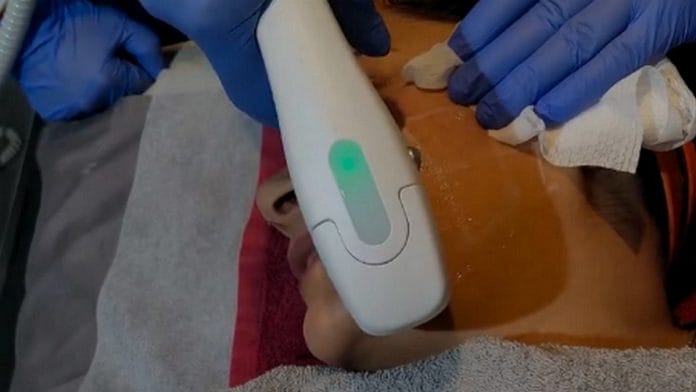If wrinkles and sagging skin had a nemesis, it might just be High-Intensity Focused Ultrasound, or HIFU. In recent years, dermatology has witnessed remarkable advancements, and this non-invasive treatment has emerged as a game-changer, particularly for skin tightening and rejuvenation.
It utilises ultrasound energy to heat specific layers of the skin, prompting a natural healing response. By targeting the dermal layers at precise depths, HIFU stimulates collagen production, leading to tighter, firmer skin. This technique has been extensively researched and has shown promising results in lifting and tightening sagging skin without the need for surgery.
So, how does HIFU work, what’s it best for, and what might it cost you? Here’s the lowdown.
Also Read: PRP Therapy is changing the hair game. It’s the ultimate antidote to thinning and baldness
How HIFU works
HIFU works through an innovative process. Ultrasound energy is delivered to the skin, passing through the epidermis without causing any damage. The energy then focuses on specific areas in the deeper layer of the dermis and potentially the superficial fascia (a layer of connective tissue), leading to thermal coagulation—a type of controlled damage.
This process triggers the body’s natural wound-healing response, resulting in increased collagen production over the weeks and months following treatment.
Patients often notice gradual improvements, with optimal results appearing around three to six months post-treatment.
What’s it effective for?
HIFU has gained popularity for its ability to treat a variety of aesthetic concerns. These include—
Skin laxity: Effective in tightening sagging skin on the face, neck, and décolleté.
Wrinkles and fine lines: Reduces the appearance of wrinkles and fine lines by promoting collagen regeneration.
Facial contouring: Provides subtle lifting and contouring, creating a more youthful appearance.
Body treatments: In addition to facial applications, HIFU can also be used on various body areas for skin tightening.
Advantages of HIFU
Why is HIFU creating such a buzz? Here are the reasons why many are turning to it.
Non-invasive: Unlike surgical procedures, HIFU does not require incisions or extensive downtime. Patients can return to their daily activities almost immediately after treatment.
Minimal discomfort: The procedure is generally easy to tolerate, with most patients experiencing only mild discomfort during the treatment.
Natural-looking results: The results from HIFU are gradual and natural, making it a preferred option for patients seeking subtle improvements without looking “overdone”.
Longevity of results: The collagen stimulation can provide results that last for up to a year or more, depending on individual factors and skin conditions.
What to expect during treatment & risks
Before undergoing HIFU, a thorough consultation with a dermatologist is essential to assess your skin condition and discuss your aesthetic goals. The treatment typically takes 30 to 90 minutes, depending on the area being treated, the machine used, the number of shots required, and the skin’s condition.
Patients may experience a slight warming sensation as the ultrasound energy is delivered. While side effects are minimal, slight redness or swelling may occur immediately following the procedure, which typically resolves quickly.
While HIFU is generally safe, it is crucial to seek treatment from a qualified and experienced dermatologist. Potential risks include:
Temporary discomfort: Some patients may experience minor swelling or tenderness for a short period after treatment.
Skin sensitivity: In rare cases, patients may experience localised bruising or changes in pigmentation.
Contraindications: Individuals with certain skin conditions or those who have had recent cosmetic procedures may not be suitable candidates for HIFU.
What does it cost?
The cost of HIFU treatments can vary significantly based on several factors, including the type of technology used, the provider’s expertise, treatment area, and geographic location.
While all HIFU devices operate on the same fundamental principle of delivering ultrasound energy to stimulate collagen production, there are different types of HIFU systems available, each with its unique features, effectiveness, and cost implications.
Traditional HIFU
This is the standard type of HIFU used for skin tightening and collagen stimulation. It can effectively treat a range of areas, including the face, neck, and body.
Cost: Rs 3,500-5,000 per session
Micro-focused ultrasound
Micro-focused ultrasound systems, such as the Ulthera system, deliver ultrasound energy at precise depths and can provide more targeted treatment options. These systems tend to be on the pricier side due to their advanced technology and proprietary features, which allow for greater customisation of treatment.
Cost: Rs 30,000-50,000 per session
Fractional HIFU
This technology breaks down the ultrasound energy into smaller, fractional beams, which can treat more areas of the skin simultaneously and reduce downtime. Fractional HIFU tends to be more expensive than traditional HIFU due to its complex programming and features.
Cost: Rs 35,000-50,000 per session
HIFU with additional features
Some devices combine HIFU with other technologies, such as radiofrequency or laser, to enhance results. These combination treatments often come at a higher price point due to the incorporation of different modalities, which can lead to enhanced efficacy and improved outcomes.
Cost: Rs 25,000-35,000 per session
Also Read: Used to pulling all-nighters? Don’t do it — your skin will remember
Is more expensive better?
While higher prices can sometimes reflect better technology or outcomes, the most expensive option isn’t always the right fit for everyone. Many dermatologists, including myself, have invested in all three types of HIFU devices.
The only problem is that consumers often don’t know the difference between technologies. And in today’s digital age, with kalyug and marketing at play, it’s tough for doctors to promote the right treatments compared to quacks and beauticians doing the same procedures, without real expertise.
As a senior dermatologist, I have witnessed the transformative effects of HIFU on my patients’ skin and self-confidence.
If you’re considering this treatment, I encourage you to consult a qualified dermatologist to ensure it aligns with your goals, safety, and budget. And don’t forget to combine it with facial yoga and an anti-inflammatory diet for the best results.
Dr Deepali Bhardwaj is a dermatologist, anti-allergy specialist, laser surgeon, and internationally trained aesthetician. She tweets @dermatdoc. Views are personal.
(Edited by Asavari Singh)






